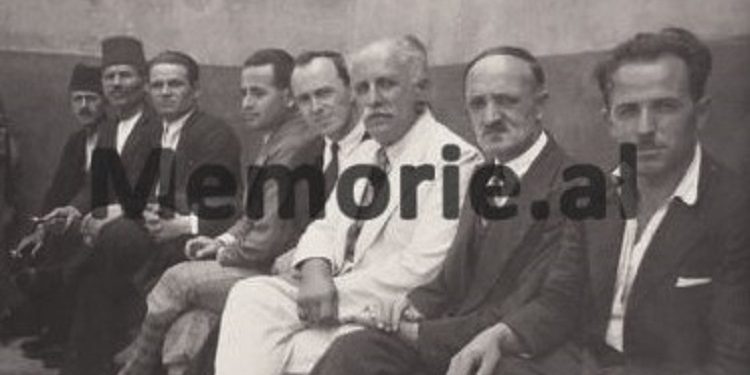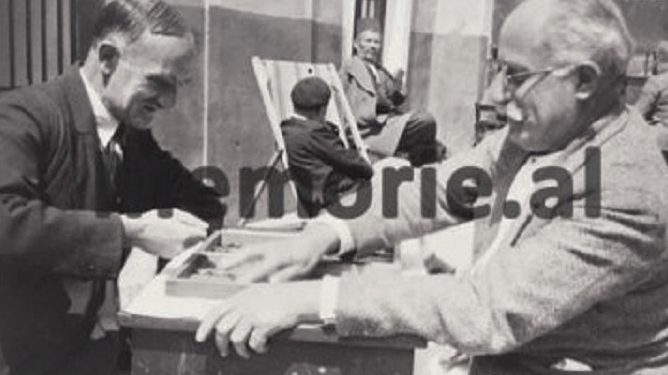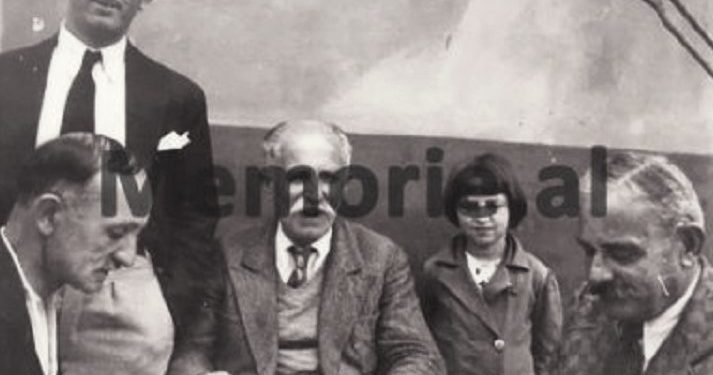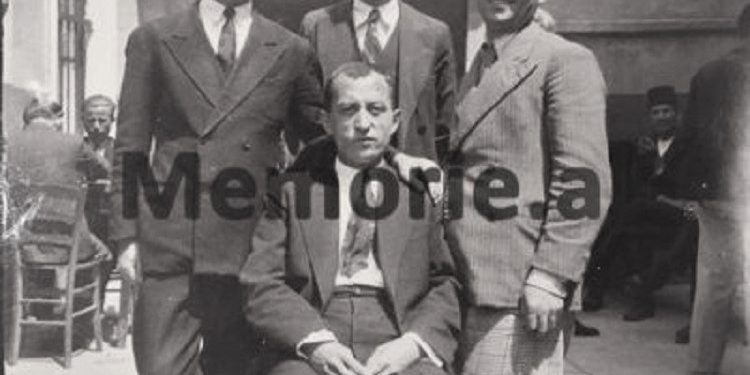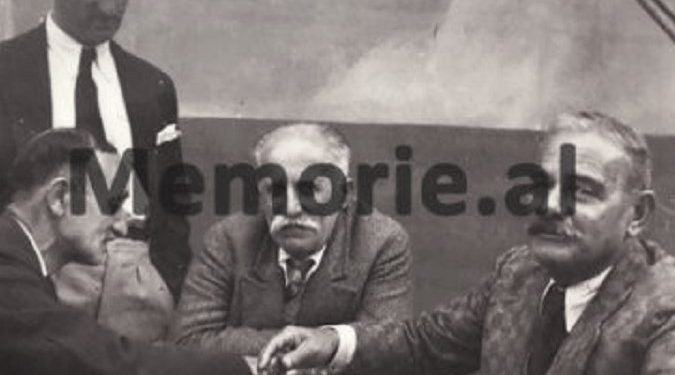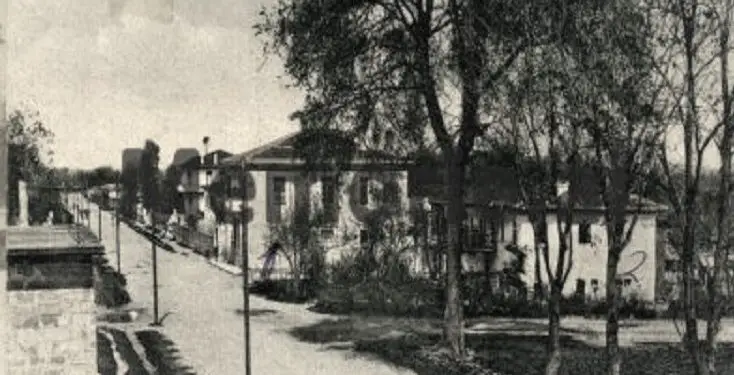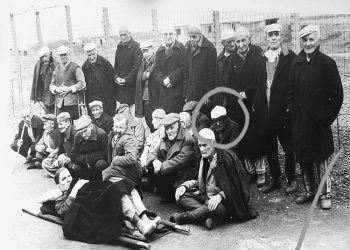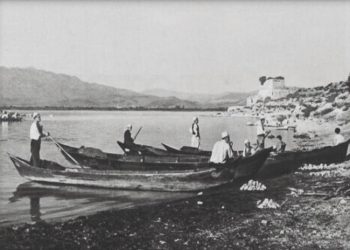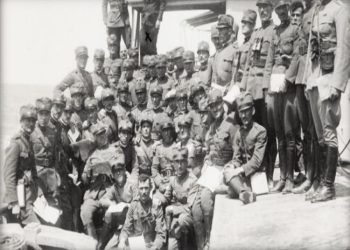Dashnor Kaloçi
Memorie.al publishes some rare and unique photos that have not been made public, which belong to 1935 in the period of the Zog Monarchy, photos that show us some rare images of some of the political prisoners who were arrested as organizers and participants of the Fier Uprising of August 1935 and were kept in isolation in the prison of that city, as: Ramiz Dibra, Ali Shefqet Skopje, Ramiz Omari, Jashar Cakrani, Beqir Sulo Agalliu, Zenel Hekali, Mustafa Kaçaçi, Dervish Hekali, etc. who were sentenced to death by the Supreme Military Court presided over by Major Ali Riza Topalli. Former senior officials and senior military from Ismail Qemali’s government and then with Fan Noli, healthy and smiling and in expensive clothes like a European aristocrat, sitting on a deck chair or sitting comfortably at tables playing backgammon, are the sights of political prisoners in the regime of “satrap” Zog…
On August 14, 1935 in the city of Fier and in some localities and villages around Myzeqe which were under the jurisdiction of the prefecture of Berat, as a result of some long-accumulated dissatisfaction, an uprising broke out against the government of King Zog, wherein led and organized by several well-known names, former senior officials and senior military since the government of Ismail Qemali in 1912 and then with Fan Noli in ’24, such as: Ali Shefqet Skopje, Ramiz Dibra , Kostë Çekrezi, Musa Kranja, Ramiz Omari, Beqir Sulo Agalliu, Zenel Hekali, Dervish Hekali, Riza Cerova, Bektash, Jashar and Namik Cakrani, etc., etc.
The antigovernmental uprising started on the morning of August 14, 1935 when the insurgent forces under the force of arms took control of some of the buildings and offices of the government administration of the Fier sub-prefecture located in the center of the city, from where they were then preparing to march. in the direction of Lushnja, Berat, etc., as the main leaders of the uprising had predicted and decided their plan, to extend it to the surrounding areas and provinces, such as Berat, Mallakastër, Kuçovë, Skrapar, Peqin, etc.
Just a short time after the uprising broke out, General Leon Gjilardi, (of Croatian origin) a former adjutant and personal friend of King Zog, the Chief Military Inspector of the Army at the Royal Court and Commander, was passing by in the center of the city of Fier in his vehicle. of the Royal Guard, who with some people accompanying him, was traveling to the park of Pojan, at the invitation of the famous French archaeologist, Leon Rey, who was doing research in that archaeological area.
The main leaders of the Fier uprising, suspecting that he had been sent by King Zog to suppress the uprising, ordered their supporters and the crowd, after blocking his vehicle, executed General Gjilardi together with his lieutenant, a lieutenant who was originally from the Greek minority area in Southern Albania.
The assassination of General Gjilardi and the more brutal way of his execution, infuriated King Zog immensely, who took measures to suppress the uprising with gendarmerie and army forces sent from Tirana, under the command of his two loyal officers, the brothers. Llesh and Gjek Marashi (from the family of the Bajraktar of Hoti in the Shkodra highlands), who arrived in Lushnje before the insurgents arrived from Fier. Thus, before dawn on August 15, the insurgent forces dispersed, handing over their weapons and some of them were arrested, while some of the main leaders of the insurgency, such as Musa Kranja and Kosta Çekrezi, escaped in a small boat to Italy. via the coast of Seman.
In the following days, in addition to the main leaders of the uprising who were in the city of Fier, government forces from Tirana arrested a large number of insurgents (their number is not accurate, as the official historiography of the pre-1990s has exaggerated their number), where most were isolated in the prison of the city of Fier. In addition, after a few days, some senior ex-servicemen who were no longer under arms were arrested in Tirana, such as Ali Shefqet Skopje (former Chief of Army Staff in the government of Ismail Qemlai), Ramiz Dibra, Ramiz Omari, Mustafa Kaçaçi etc., who were accused of being the main leaders of the Fier Uprising, since a year ago, in 1934, they had established a secret organization based in Tirana and its branches in several districts which had for the purpose of overthrowing King Zog.
After some time of investigation, they appeared in court before the Supreme Military Court headed by Lieutenant Colonel Ali Riza Topalli and most of the leaders of the uprising were sentenced to death by firing squad, while others were sentenced to long prison terms for their crimes. But the trial against them, as well as the death sentences handed down by that court, had a great reaction not only within the country, but also in the international arena, where there were several protests, even by well-known personalities of politics, science and art. As a result of this, but also of Zogu’s generosity, the death row inmates were pardoned by Zogu decree and initially they were sentenced to 101 years in prison. But from some amnesties granted that year, none of the convicts did more than three years in prison. While the only one who was sentenced to death and was not spared his life, was Hekuran Mëneku, the person who shot and killed General Gjilardi and his ordinance, who was hanged on a rope in the center of the city of Fier, exactly in the place where he had committed his crime.
All of the above are already known events and facts from the period of the communist regime, as official historiography has paid much attention to this uprising, presenting its suppression by King Zog, as if it was done with the utmost severity and that its main leaders were subjected to the cruelest tortures in the prison of the city of Fier, where they were kept in isolation until they went to trial. But does this fact stand, that is, the tortures that were inflicted on the main leaders of that uprising? Among other things, the most accurate answer about this event is given by some rare and unique photos that must be said, which Memorie.al makes public for the first time, where some of the main leaders of the Fier Uprising and anti-Zogists of known as: Ali Shefqet Skopje, Ramiz Dibra, Beqir Sulo Agalliu, Ramiz Omari, Mustafa Kaçaçi, etc., who are isolated in Fier prison.
As can be seen in the photos in question, the above-mentioned persons and all the main leaders of that uprising, who are in that prison awaiting the execution of the death sentence, are wearing expensive clothes. They also look quite healthy with humor and laughter, playing backgammon and talking to each other, where one of them has his little niece nearby. So, this is the image that existed at that time in the prisons of “satrap” Zog, images that speak a lot, because there are no prison signs, (there are no police or gendarmes), as we are used to seeing in those few photos or videos served to us by the communist period. But unlike these photos, in the prisons of the communist regime of Enver Hoxha, political prisoners look like living corpses and those awaiting the death penalty were kept tied with ropes and helmets. / Memorie.al




